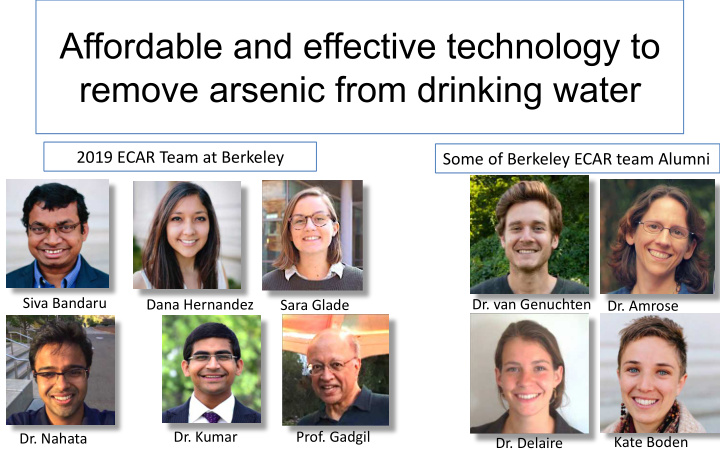



Affordable and effective technology to remove arsenic from drinking water 2019 ECAR Team at Berkeley Some of Berkeley ECAR team Alumni Siva Bandaru Dana Hernandez Sara Glade Dr. van Genuchten Dr. Amrose 1 Dr. Kumar Prof. Gadgil Dr. Nahata Kate Boden Dr. Delaire
Why is it important to urgently address arsenic in drinking water on a massive scale? Global climate change, increasing populations, and increasing prosperity, all drive water demand, causing increasing reliance on groundwater. Arsenic is a far more potent carcinogen than any other regulated carcinogen, at their respective MCLs, World map of groundwater arsenic in drinking water. 2
MCL == Maximum (permitted) Contaminant Level allowed in drinking water, e.g., by US EPA. Only showing water-borne regulated carcinogens, excluding arsenic (which we will include next). Risks compilation taken from Smith et al (2002), Science, Vol. 296, pp.2145-2146.
Cancer risk from Arsenic at its MCL (10 ppb). Note vertical scale. Arsenic cancer risk is ~0.7 per 100. Note risk for other carcinogens at their MCL shown in blue columns (near the X-axis) from the previous slide. Risk references: US EPA (2010), “Toxicological Review of Inorganic Arsenic (Cancer).” EPA/635/R-10/001. Smith et al (2002), Science, Vol. 296, pp. 2145-2146.
Arsenicosis started appearing in early 1990s in West Bengal and Bangladesh, and there is still no solution! Arsenicosis causes painful skin lesions, IQ decrease in children, gangrene and amputation, cancers, (+ other effects), and death 5
Technology, “ECAR”, was invented for affordable and robust removal of Arsenic. Research started in Berkeley with small seed-funding in 2005 invented at Berkeley Lab 2006 testing at Jadavpur University, 2012
ECAR was designed to fit within a sustainable and scalable system, with zero liquid discharge ECAR = Electro-Chemical Arsenic Remediation How does ECAR work? The Big Picture All of As-III is Fe-II is produced, oxidized to As- oxidizes to Fe-III, and V; much easier precipitates as Hydrated to adsorb and Fe-III-OxyHydroxides remove. (“HFO”) P, Si, and As-V chemically sorb to HFO Then settle out as sludge 7
Field Site is at Dhapdhapi High School, outside Kolkata, India Pilot Plant designed to treat 10,000 L /day; consumables cost: 1/20 cent/L 2016. Team photo in front of two 1400L reactors at the field site in West Bengal. 8
ECAR reduces Arsenic from groundwater to safe levels ECAR: ElectroChemical Arsenic Remediation Initial Arsenic Concentration 252 ± 29 parts per billion (ppb) 12 Arsenic Concentration (ppb) World Health Organization’s Guideline Value 10 ppb 10 8 6 Average 2.9 ppb 4 2 0 r r y n l g g v c c n n n y n l g p p t t v u p p u c c a a u u u u u o o e e a a e e a J O O J A A M D M J A S S N D J J - - A A N J J - - - 8 - - 4 - - - - 6 0 - - - 2 6 0 - - - - - 1 5 - 2 6 - - 0 4 1 1 5 9 1 5 9 9 3 7 1 3 2 1 2 1 2 1 2 1 2 1 2 2 Arsenic in treated water. April 11, 2016 to January 30, 2017. Dhapdhapi High School, West Bengal, India
2017. Students and staff use electronic cards to access safe water from water dispensing kiosk
Lifetime cancer risk from drinking water with arsenic at 250 ppb, (typical of groundwater in arsenic-affected areas). 18 per 100 . 60-X Reduction in risk at affordable price: Safe Water sells at 1 cent US / Liter arsenic at 10 ppb. Lifetime risk is ~0.7 per 100.
ECAR technology is successfully field-tested, piloted, and shown commercially viable. It is operating since 2016 at one site in India, serving thousands of people daily Two Indian firms have licensed the technology from University of California, LBNL For our journal publications, news, and videos, please visit: GadgilLab.Berkeley.edu 12
Recommend
More recommend